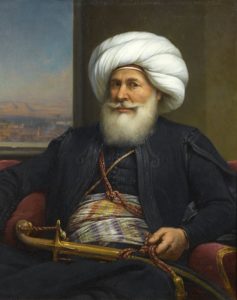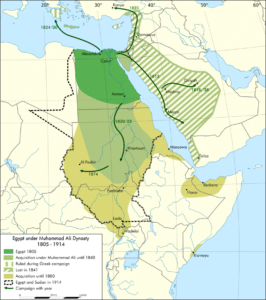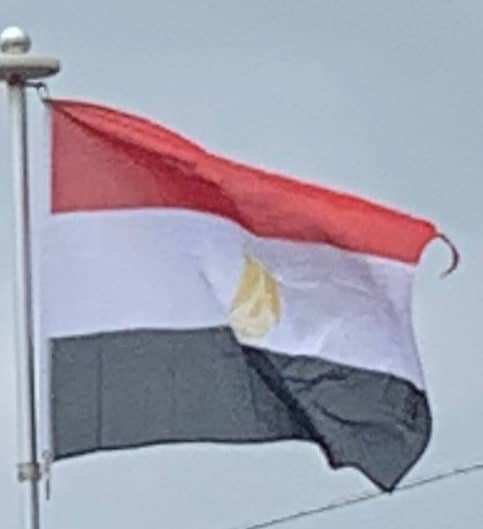
The introduction in 1820 of long-staple cotton transformed its agriculture into a cash-crop monoculture before the end of the century, concentrating land ownership and shifting production towards international markets.
Muhammad Ali annexed Northern Sudan (1820–1824), Syria (1833), and parts of Arabia and Anatolia; but in 1841 the European powers, fearful lest he topple the Ottoman Empire itself, forced him to return most of his conquests to the Ottomans. His military ambition required him to modernize the country: he built industries, a system of canals for irrigation and transport, and reformed the civil service.
He constructed a military state with around four percent of the populace serving the army to raise Egypt to a powerful positioning in the Ottoman Empire in a way showing various similarities to the Soviet strategies (without communism) conducted in the 20th century.
Muhammad Ali Pasha evolved the military from one that convened under the tradition of the corvée to a great modernized army. He introduced conscription of the male peasantry in 19th century Egypt, and took a novel approach to create his great army, strengthening it with numbers and in skill. Education and training of the new soldiers became mandatory; the new concepts were furthermore enforced by isolation. The men were held in barracks to avoid distraction of their growth as a military unit to be reckoned with. The resentment for the military way of life eventually faded from the men and a new ideology took hold, one of nationalism and pride. It was with the help of this newly reborn martial unit that Muhammad Ali imposed his rule over Egypt.

The policy that Mohammad Ali Pasha followed during his reign explains partly why the numeracy in Egypt compared to other North-African and Middle-Eastern countries increased only at a remarkably small rate, as investment in further education only took place in the military and industrial sector.
Muhammad Ali was succeeded briefly by his son Ibrahim (in September 1848), then by a grandson Abbas I (in November 1848), then by Said (in 1854), and Isma’il (in 1863) who encouraged science and agriculture and banned slavery in Egypt.
Khedivate of Egypt (1867-1914):
Egypt under the Muhammad Ali dynasty remained nominally an Ottoman province. It was granted the status of an autonomous vassal state or Khedivate in 1867, a legal status which was to remain in place until 1914 although the Ottomans had no power or presence.
The Suez Canal, built in partnership with the French, was completed in 1869. Its construction was financed by European banks. Large sums also went to patronage and corruption. New taxes caused popular discontent. In 1875 Isma’il avoided bankruptcy by selling all Egypt’s shares in the canal to the British government. Within three years this led to the imposition of British and French controllers who sat in the Egyptian cabinet, and, “with the financial power of the bondholders behind them, were the real power in the Government.”
Other circumstances like epidemic diseases (cattle disease in the 1880s), floods and wars drove the economic downturn and increased Egypt’s dependency on foreign debt even further.
